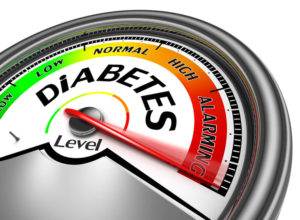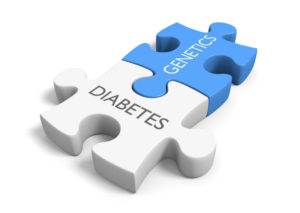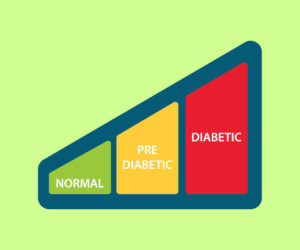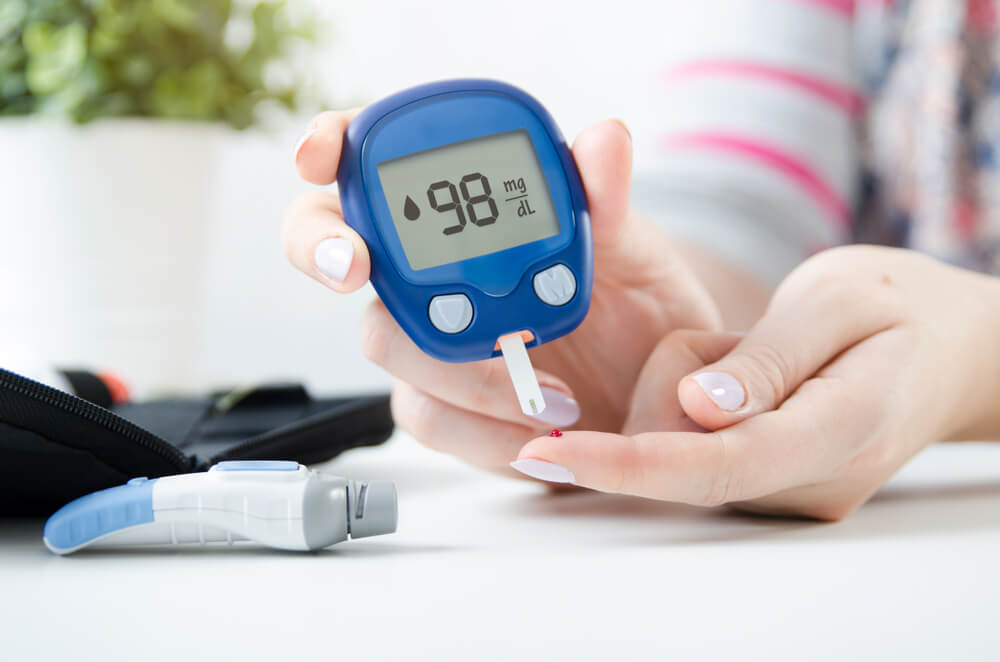 |
Dr. Eno Nsima-Obot, MD Functional Medicine Doctor Type 2 Diabetes expert |
Definition | Risk Factors | Genetics vs. Lifestyle | Symptoms | Type I Diabetes | Pre Diabetes | Treatment
According to a recently released CDC report, there are now over a hundred million Americans living with either type 2 diabetes or pre-diabetes. Diabetes and pre-diabetes have reached epidemic proportions. In order to reduce your own risk, it is important to learn more about the disease. What is type 2 diabetes and how can the epidemic be slowed down?
What Is Type 2 Diabetes?
Type 2 diabetes is caused by a condition called insulin resistance. In other words, the cells of the body are resistant or not properly reacting to the effects of insulin. The role of insulin is to signal to the body’s cells that there is sugar available after a meal. If insulin is not working properly, glucose or sugar does not get taken into the cells efficiently and remains in the bloodstream. This leads to high blood (sugar) glucose levels which is the hallmark for diabetes.
When I explain insulin resistance to a patient or a client, I use the metaphor of a landlord that who changes the locks to the tenant’s front door. I compare insulin resistance to when you get home, the door is locked and you can’t get into your apartment. With insulin resistance, insulin can no longer get into the cell through the receptors. The “key” no longer fits. Because the cell receptors are not working, the glucose blood sugars build up in the bloodstream and eventually causes high blood sugar and type 2 diabetes symptoms.
We often call type 2 diabetes a disease of lifestyle. Although genetics can play role in type 2 diabetes, many contributing risk factors of the disease are lifestyle choices. The obesity epidemic actually parallels increase in the incident of type 2 diabetes. Risk factors for developing diabetes include:[1]
- A diet high in processed food and sugar
- A sedentary lifestyle
- Excessive, uncontrolled stress
- Poor sleep habits
- Race- African Americans, Hispanics, American Indians, and Asians are at greater risk
- Family history
- The presence of other health conditions, such as high blood pressure, high cholesterol, excessive weight particularly around the mid-section- collectively called metabolic syndrome.
- Gestational diabetes
Other Risk Factors for Type 2 Diabetes

There are some other contributing factors that should be monitored. Watch out for these lesser-known causes:
- Environmental toxin exposure can affect mitochondrial health and increase the risk of insulin resistance. Environmental toxins may also come from pesticides and chemical exposures. There has even been association between Veterans from the Vietnam War who were exposed to Agent Orange or other herbicides during military service, and a higher rate of type 2 diabetes.[2]
- Certain medications, even those we need to treat serious medical conditions, can make you more prone to type 2 diabetes. These include medications for high blood pressure, beta blockers, steroids and transplant medications, just to name a few. If you need to take these medications, the risk factors need to be weighed against the possible benefits.
- Finally, the contribution of stress and poor sleeping habits to health is frequently forgotten. When you are stressed out and not sleeping, you have a cortisol response, which is superimposed on your insulin resistance, raising blood sugar even more. Being able to manage stress, get better sleep, and maybe even find a higher spiritual purpose can all be therapies we recommend for healing and good health.
How Much Does Genetics Factor In To Developing Type 2 Diabetes?

Do “bad genes” make diabetes an absolute in your future? As much as type 2 diabetes is a lifestyle disease, you can’t forget the impact of family history.
In functional medicine we call it an antecedent, something that is present that could increase your risk for exposure to a certain disease. Genetics is like a loaded gun, lifestyle is what pulls the trigger.
Yes, there is an association genetically, especially if both parents have diabetes. This does not mean that if your parents have diabetes that it’s over for you. Diabetes is not inevitable. If anything, it should make you more aware of the need to focus on implementing healthy lifestyle choices.
Ask yourself, what can I do to prevent diabetes? Am I watching what I eat? Am I exercising? Am I limiting my exposure to environmental toxins? How am I managing stress in my life?
The reason many people with a genetic risk develop diabetes is because they may tend to fall into the same lifestyle they were raised in. If you grew up in a family that ate a lot of fast food and sugary drinks, then you are more likely to eat that way as an adult. How we eat as a family unit plays a huge role in our risk of developing a chronic disease.
The Difference Between Type 1 Diabetes and Type 2 Diabetes
Many people confuse type 1 from type 2 diabetes, because they have less information on what type 1 diabetes is. Type 1 diabetes, which used to be called juvenile onset diabetes, is a condition you develop at an early age due to an autoimmune disorder.
An autoimmune disorder is when the body forms antibodies against its own cells. In the case of type 1 diabetes, the body forms antibodies against the beta cells that make insulin in the pancreas. This leads to a life-long deficiency of insulin. People with type 1 diabetes have to use insulin to maintain normal blood sugar levels.
The main difference between type 1 and type 2 diabetes is the cause – type 1 is autoimmune and type 2 usually acquired being an outcome of certain lifestyle habits.
What Is Pre-diabetes?
 Pre-diabetes is also known as borderline diabetes. Currently there are over 80 million American adults living with pre-diabetes. And you know the scary thing? Majority of these people are unaware of this.
Pre-diabetes is also known as borderline diabetes. Currently there are over 80 million American adults living with pre-diabetes. And you know the scary thing? Majority of these people are unaware of this.
Being able to identify pre-diabetes and educate patients that pre-diabetes is a serious medical condition is the key to preventing type 2 diabetes and the devastating health consequences that it brings.
Your healthcare provider will usually screen you for type 2 diabetes especially if you are over the age of 45. This is usually performed by a fasting blood sugar, where you haven’t had anything to eat or drink in 8-12 hours.
The acceptable fasting blood sugar ranges are:
- Non-diabetes: 100 mg/dL or less
- Pre-diabetes: 101-125 mg/dL
- Diabetes: 126 mg/dL or more
If you have pre-diabetes, this means you are at risk for developing diabetes. Ninety percent of people with prediabetes don’t even know they have it. This is the stage that we really need to focus on making lifestyle changes in order to reduce the progression to type 2 diabetes.
It is important to understand that pre-diabetes is not a benign condition. Once you’ve reached this stage, you may have already begun to suffer from what we call microvascular complications. The nerves are already being affected and kidney damage is already occurring. When it comes to high blood sugar levels, you may think of sugar as a knife in the body, destroying delicate, tiny blood vessels in the organs. Anytime blood sugar is too high it can cause damage, even with pre-diabetes.
By the time you progress to type 2 diabetes you may already have all these complications and you just got diagnosed. That’s because the damage started back in the pre-diabetes phase. The body was already undergoing changes in the vasculature that was damaging critical organs.
One reason pre-diabetes isn’t taken seriously is because many doctors don’t have the time to have a lengthy conversation with their patients about their blood sugar. Sometimes when a patient’s blood sugar is not very high they might say, “you know, your blood sugar is a little high, watch your diet” without much further guidance. But, stepping in at the prediabetes phase is when we can make the most impact with lifestyle change.
Functional medicine doctors, who seek to treat root causes of disease, will already start to alert and educate a patient when they reach a blood sugar level of around 90. That’s how awareness of insulin resistance and its effects on blood sugar is.
If you’re healthcare provider does not appear to be taking a diagnosis of pre-diabetes seriously, you need to become your own advocate. Ask questions, find out how often you need to get monitored, and what the next steps are. Better still, find a way to work with a functional medicine doctor who will help address the root cause, and then use this information to bring this blood sugar level down.
Signs and Symptoms of Type 2 Diabetes
Diabetes can be called a “silent killer” because by the time you start to feel bad and have symptoms you are already pretty advanced in the disease.
By the time most people begin to experience the classic symptoms of diabetes, their blood sugars are usually in the 300 mg/dL (16.6 mmol/L0 range).
The classic symptoms of type 2 diabetes include:
- Excessive thirst
- Uncontrolled hunger
- Poor wound healing
- Frequent urination
- Fatigue
- Poor wound healing
- Blurred vision
- Irritability
Most people who have pre-diabetes or are early on in developing type 2 diabetes feel perfectly fine. They usually don’t have any of the above symptoms at that stage. By the time you start feeling symptoms, the damage may have already been done. This is why it is so important to fight rising blood sugar early.
There are other atypical symptoms that could alert you to earlier that you might have elevated blood sugar levels. For women, frequent yeast infections with no other known cause may be a sign. If you start to experience this, you should have your blood sugar checked.
Another is a skin condition called Acanthosis nigricans, which are velvety dark patches of skin around the neck and elbows among other places. Skin tags can also be a sign of insulin resistance particularly in men.
Many people, however, may experience no symptoms at all. This is why it is critically important to have your blood sugar screened regularly, so you can take action before developing any complications.
Talking About Metabolic Health In Relation To Type 2 Diabetes
 Only 12% of American adults are metabolically healthy. Metabolic health entails a normal body weight, normal BMI, normal blood sugar, normal cholesterol and normal waist circumference. This is something I’m very passionate about and want to shine light on as it and how it relates to obesity and the type 2 diabetes epidemic.
Only 12% of American adults are metabolically healthy. Metabolic health entails a normal body weight, normal BMI, normal blood sugar, normal cholesterol and normal waist circumference. This is something I’m very passionate about and want to shine light on as it and how it relates to obesity and the type 2 diabetes epidemic.
There’s a difference between saying, “hey, I’m just a little thick,” and having visceral or abdominal obesity. If you’re a woman, a waist circumference of over 35 or for men over 40, this means you have visceral obesity.
When fat is concentrated in the mid-section, you most likely have intra-abdominal fat. This is fat around the organs. This fat is metabolically active and leads to all sorts of complications. A high waist-circumference has been linked to a greater risk for:
- Chronic inflammation
- Type 2 diabetes
- High blood pressure
- High cholesterol
- Heart disease
- Certain cancers
- Liver disease
This is how I end up seeing patients with end-stage liver disease who don’t drink alcohol. Too many people drink a lot of soda every single day, not knowing it can cause liver damage by the inflammation a substance called high fructose corn syrup causes. Under a microscope the liver looks exactly the same as drinking excessive alcohol. This is called non-alcoholic steatohepatitis (NASH). It just makes me want to say to people, stop drinking soda, it will destroy your liver.
Can Type 2 Diabetes Be Reversed?
In the past, we thought type 2 diabetes was the equivalent of a death sentence. We thought that it could not be reversed so we presented people with this diagnosis that pretty much left them with the option to take insulin and wait to die.
Even now, when a diagnosis is received patients get very frustrated and start wondering if they will inevitably end up on insulin. It all depends on how soon the condition is caught which is why the pre-diabetes stage is so important. The sooner we can detect this and take measures to prevent the progression, the less likely you are to end up on insulin.
If left uncontrolled, with time, the beta cells in the pancreas burn out. At this point, insulin can no longer be produced. And this is when someone with type 2 diabetes may need treatment with insulin. It may seem on the surface that there is no difference between type 1 and type 2 diabetes. The goal should be to stop the progression of type 2 diabetes.
Today, through various studies, we can say that type 2 diabetes can be managed with lifestyle changes. There are many ways we can assist the body to heal and maintain a normal blood sugar.
For example, a study at Indiana University showed people were able to maintain normal blood sugar levels by following a low-carb diet. Low carb diets, and there are several kinds, are usually best for reversing diabetes. We’ll discuss these dietary approaches next.
Read Next
What Is The Best Diet For Type 2 Diabetes?
- What Is The Best Diet For Type 2 Diabetes? - September 23, 2019
- The Type 2 Diabetes Epidemic: Shocking Facts You Have To Know - September 23, 2019




